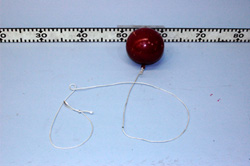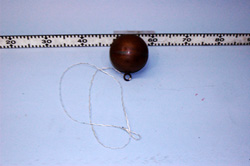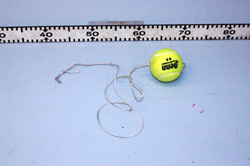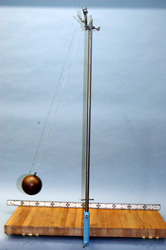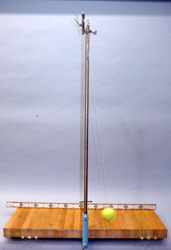Simple Pendulum, 3A10.10
Topic and Concept:
Oscillations, 3A10. Pendula
pira200 Listed
Location:
Cabinet: Mechanic (ME)
Bay: (A2)
Shelf: #1
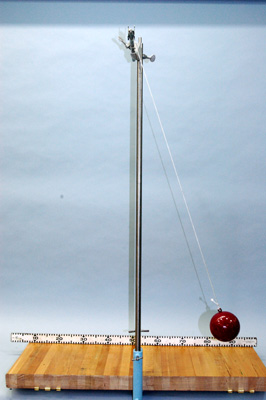
Abstract:
Suspend a simple pendulum from a ringstand or hold by hand, and provide some energy allowing it to oscillate.
Equipment |
Location |
ID Number |
|
|
|
Ball on a String |
ME, Bay A2, Shelf #1 or hanging in tack cabinet near main lecture halls |
|
Important Setup Notes:
- If using the brass ball, be careful not to dent the thin metal.
Setup and Procedure:
If using the rod & clamp to suspend the pendulum (the preferred method), attach the support rod to the bench with the clamp.
- Attach a cross-bar on the top using a right-angle bracket, and slip the loop end of the string over the rod.
- If desired, use a binder clip to keep the string in place.
- Pull the ball back from equilibrium to some arbitrary height while keeping the string taught and release.
- If using your hand, suspend the pendulum from one hand.
- Using the other free hand, pull the ball back from equilibrium to some arbitrary height while keeping the string taught and release.
Cautions, Warnings, or Safety Concerns:
- N/A
Discussion:
When the ball is pulled back from equilibrium, at the point of lowest potential, it is given potential energy. Once released, there is a net force on the ball due to gravity so the ball falls. The potential energy changes to kinetic energy as the ball falls. Thus the speed of the ball increases reaching a maximum at the point of lowest potential. The amount of kinetic energy the ball has is dependent on it's height at a given time being constrained by the conservation of energy: Etotal = U + T where U is potential energy and T is kinetic energy. The ball has momentum while it is moving, but this is constantly changing as the direction of the tension force is constantly changing with displacement angle. If the system were perfectly conservative (i.e. there was not any air resistance or friction), the ball would oscillate indefinitely swinging in a plane reaching a maximum height (the height up to which the ball was originally pulled) and stopping then reversing direction. In practice, however, there is always energy loss in such systems, and the pendulum will eventually come to a halt and assume its original equilibrium position at the point of lowest potential.
|
|
|
|
|
|
Videos:
References:

